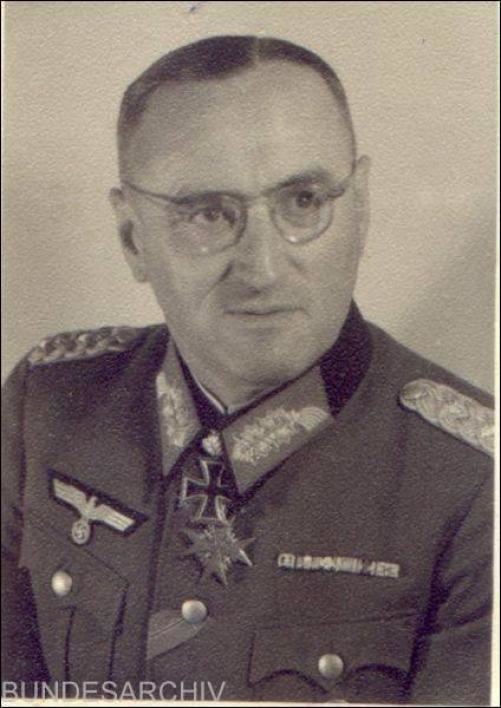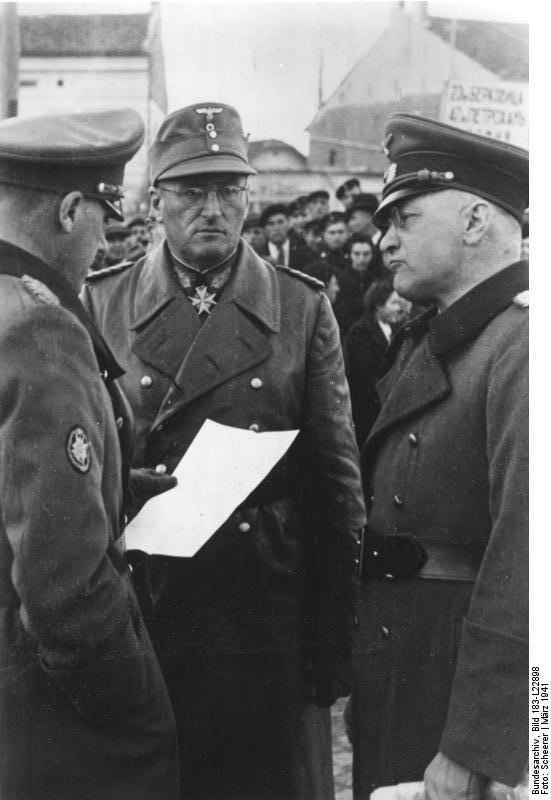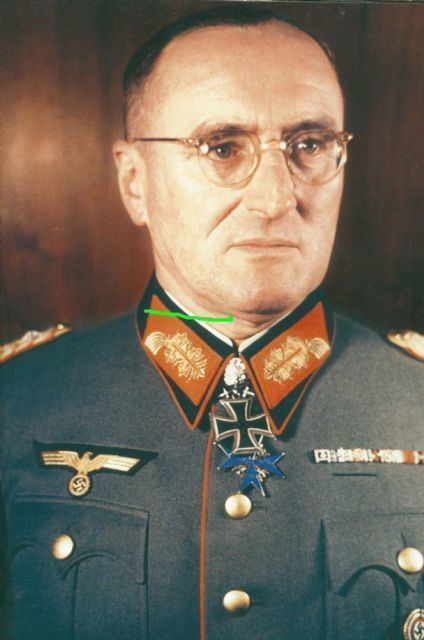Years of service 1911–45 | Name Ferdinand Schorner Role Military Commander | |
 | ||
Nickname(s) Blutiger Ferdinand (Bloody Ferdinand) Battles/wars See battles World War IBattle of CaporettoWorld War IIInvasion of PolandBattle of LwowBattle of GreeceBattle of Metaxas LineBattle of Tempe GorgeBattle of ThermopylaeBattle of CreteDnieper-Carpathian OffensiveNikopol-Krivoi Rog OffensiveOperation BagrationLublin-Brest OffensiveBattle of RomaniaSecond Battle of Targu FrumosBaltic OffensiveRiga OffensiveTallinn OffensiveMoonsund Landing OperationCourland PocketVistula-Oder OffensiveLower Silesian OffensiveUpper Silesian OffensiveBattle of BerlinBattle of BautzenPrague Offensive Similar People Walter Model, Paul Ludwig Ewald vo, Ivan Konev, Gotthard Heinrici, Wilhelm Ritter von Leeb | ||
Ferdinand Schörner (12 June 1892 – 2 July 1973) was a general and later Field Marshal in the Wehrmacht of Nazi Germany during World War II. He commanded several army groups and was the last commander of the Oberkommando des Heeres (Supreme Command of the Army, the OKH).
Contents
- Early life
- World War II
- Post war trials and convictions
- Assessment
- Dates of rank
- Awards and decorations
- References

Schörner was a convinced Nazi and became well known for his brutality. By the end of World War II he was Hitler's favorite commander. Following the war he was convicted of war crimes by courts in the Soviet Union and West Germany and was imprisoned in the USSR, East Germany and West Germany. At his death in 1973 he was the last living German Field Marshal.

Early life

Schörner was born on June 12, 1892 in Munich, German Empire. A veteran of World War I, he was awarded the Pour le Mérite military order as a lieutenant when he took part in the Austro-Hungarian and German Battle of Caporetto, which shattered the Italian lines in the fall of 1917.

Schörner served as a staff officer and instructor between the two wars. In 1923 he was adjutant to General von Lossow, the commander of Military District VII in Munich, and participated in the defeat of the Beer Hall Putsch.
World War II

Schörner commanded the 98th Mountain Regiment in the Invasion of Poland in 1939. During the 1941 Balkans campaign, he commanded the German 6th Mountain Division and earned the Knight's Cross for his role in breaching the Metaxas Line. With this division, Schörner took part in Operation Barbarossa in June 1941. The 6th Gebirgs Division was assigned to the Arctic sectors in the Eastern Front. In 1942 as a General der Gebirgstruppe he took command of the XIX Mountain Corps, part of the German Army in Finland. With this command he participated in the failed attack on Murmansk and the stalemate war that resulted from it. Schörner's primary job was to keep the Pechenga Nickel Works in German hands. When the Soviets opened an offensive against the Arctic sector, the division took part in the fighting. In January 1942, Schörner was promoted to the rank of Generalleutnant, commanding the Mountain Corps Norway.
He later commanded the German XXXX Panzer Corps on the Eastern Front from November 1943 to January 1944. In March 1944 he was made commander of Army Group A, and in May commander of Army Group South Ukraine. After initially stating that the Crimean port of Sevastopol could be held for a long time even if Crimea fell, he changed his mind and, against Hitler's wishes, evacuated the Black Sea port. This retreat occurred too late, and the German/Romanian 17th Army that was holding Crimea suffered severe losses, with many men killed or captured while waiting on the piers to be evacuated. During the late spring of 1944, Schörner managed to stabilize the crumbling front in the south in a series of defensive battles on the Dniester River in Romania.
Schörner was promoted to the rank of Generaloberst in April 1944. In July he became commander of Army Group North, which was later renamed Army Group Courland, where he stayed until January 1945 when he was made commander of Army Group Centre, defending Czechoslovakia and the upper reaches of the River Oder. He became a favorite of high-level Nazi leaders such as Joseph Goebbels, whose diary entries from March and April 1945 have many words of praise for Schörner and his methods. Finally, on 4 April 1945, Schörner was promoted to field marshal and was named as the new Commander-in-Chief of the German Army (Oberbefehlshaber des Heeres) in Hitler's last testament. He nominally served in this post until the surrender of the Third Reich on 8 May 1945, but in reality, continued to command his army group, since no staff was available to him. He did not have any discernible influence in the final days of the Reich. He was one of only 27 people to be awarded the Knight's Cross of the Iron Cross with Oak Leaves, Swords and Diamonds.
On 7 May, the day General Alfred Jodl, Chief-of-Staff of German Armed Forces High Command (German acroynym OKW), was negotiating the surrender of all German forces at SHAEF, the last the OKW had heard from Schörner was on 2 May. He had reported he intended to fight his way west and surrender his army group to the Americans. On 8 May, "OKW" Colonel Wilhelm Meyer-Detring was escorted through the American lines to contact Schörner. The colonel reported that Schörner had ordered his operational command to observe the surrender, but he could not guarantee that he would be obeyed everywhere. In fact, Schörner ordered a continuation of fighting against Red Army and Czech insurgents. Later that day, Schörner deserted his command and flew to Austria, where he was arrested by the Americans on 18 May. Elements of Army Group Centre continued to resist the overwhelming force of the Red Army liberating Czechoslovakia during the final Prague Offensive (Prague itself being liberated by local Czechs and anti Communist "White Russians" who turned against the Germans). Units of Army Group Centre, the last major German units to surrender, capitulated on 11 May 1945.
Post-war trials and convictions
Schörner was arrested in August 1951 by the Soviet authorities on charges of war crimes. In February 1952 the Military Board of the USSR Supreme Court sentenced him to 25 years' imprisonment. A decree of the Presidium of the Supreme Soviet in April 1952 reduced this sentence to 12 and a half years. A decree of December 1954 allowed him to be handed over to authorities of the German Democratic Republic, who allowed him to leave for West Germany in 1958. There he was arrested and charged with the illegal executions of German Army soldiers accused of desertion. He was found guilty and sentenced to four and a half years' jail, which he served. He was released in 1963 and lived in obscurity in Munich until his death in 1973. In the late 1960s he gave a lengthy interview to Italian historian Mario Silvestri that centered on his role and actions during the Austro-German victory at the battle of Caporetto in World War I rather than on his World War II service.
Assessment
German veterans particularly criticized Schörner for a 1945 order that all soldiers found behind the front lines, who did not possess written orders to be in that particular area, were to be court-martialed on the spot and hanged if found guilty of desertion. This is mentioned in the writings of Siegfried Knappe, Hans von Luck, and Joseph Goebbels. "Deserters get no mercy from him," Goebbels wrote of Schörner on 11 March 1945. "They are hanged from the nearest tree with a placard round their necks saying: 'I am a deserter. I have declined to defend German women and children and therefore I have been hanged.'" The approving Goebbels continued with, "Naturally such methods are effective. Every man in Schörner's area knows that he may die at the front but will inevitably die in the rear." Gottlob H. Bidermann, a German infantry officer who served in Schörner's command in 1944-45, reported in his memoirs that the General was despised by officers and men alike.
Schörner was said to never have uttered a word of praise, and would demote or punitively transfer soldiers on the spot for the most minor infractions, even as the war was ending. Bidermann was especially bitter that while Schörner's men were marched off to die in Soviet POW camps at the cessation of hostilities, Schörner made certain that he personally avoided their fate. When captured by the Americans in their sector, Schörner is said to have been dressed as a Bavarian non-combatant, behavior for which he had only recently had his own soldiers executed.
Though despised by his men, Schörner was loved in Berlin. He was very devoted to Hitler, a view that is seen as confirmed by Hitler's appointment of Schörner as his replacement as Commander-in-Chief of the German Army on his suicide; (see Hitler's Last Will). Moreover, Schörner did not hesitate to second Hitler's daydreams in the last weeks of the war, agreeing that the Red Army's main objective would be Prague instead of Berlin (in itself a colossal strategic blunder), and so leading him to weaken the already critically thin defense lines in front of the German capital to counter this perceived threat. Historian Ian Kershaw described him in 2011 (BBC History Magazine) as "extraordinarily brutal".
In his book "The End" (p. 50), Kershaw describes Schörner as "a fanatical (Nazi) loyalist", an indication of this being that he had served for a brief spell in March 1944 as Chief of the NS Leadership Staff of the Army. The latter was responsible for coordinating relations between the military and the Nazi Party.
